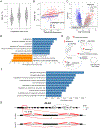Genetics of Gene Expression in the Aging Human Brain Reveal TDP-43 Proteinopathy Pathophysiology
- PMID: 32526197
- PMCID: PMC7416464
- DOI: 10.1016/j.neuron.2020.05.010
Genetics of Gene Expression in the Aging Human Brain Reveal TDP-43 Proteinopathy Pathophysiology
Abstract
Here, we perform a genome-wide screen for variants that regulate the expression of gene co-expression modules in the aging human brain; we discover and replicate such variants in the TMEM106B and RBFOX1 loci. The TMEM106B haplotype is known to influence the accumulation of TAR DNA-binding protein 43 kDa (TDP-43) proteinopathy, and the haplotype's large-scale transcriptomic effects include the dysregulation of lysosomal genes and alterations in synaptic gene splicing that are also seen in the pathophysiology of TDP-43 proteinopathy. Further, a variant near GRN, another TDP-43 proteinopathy susceptibility gene, shows concordant effects with the TMEM106B haplotype. Leveraging neuropathology data from the same participants, we also show that TMEM106B and APOE-amyloid-β effects converge to alter myelination and lysosomal gene expression, which then contributes to TDP-43 accumulation. These results advance our mechanistic understanding of the TMEM106B TDP-43 risk haplotype and uncover a transcriptional program that mediates the converging effects of APOE-amyloid-β and TMEM106B on TDP-43 aggregation in older adults.
Keywords: Alzheimer's disease; Amyloid-β; GRN; RBFOX1; TDP-43; TMEM106B; co-expression module; cognitive resilience; eQTL; expression quantitative trait loci; sQTL; splicing quantitative trait loci.
Copyright © 2020 Elsevier Inc. All rights reserved.
Conflict of interest statement
Declaration of Interests P.L.D. serves on a scientific advisory board for Neuroimmunology Newco, Roche, Biogen, and Celgene; has a sponsored research agreement with Biogen and Roche; and has fellowship funding through Genentech, outside the submitted work. All other authors declare no competing interests.
Figures





References
-
- Albert FW, and Kruglyak L (2015). The role of regulatory variation in complex traits and disease. Nature reviews Genetics 16, 197–212. - PubMed
-
- Allen M, Wang X, Burgess JD, Watzlawik J, Serie DJ, Younkin CS, Nguyen T, Malphrus KG, Lincoln S, Carrasquillo MM, et al. (2018a). Conserved brain myelination networks are altered in Alzheimer's and other neurodegenerative diseases. Alzheimer's & dementia : the journal of the Alzheimer's Association 14, 352–366. - PMC - PubMed
-
- Allen M, Wang X, Serie DJ, Strickland SL, Burgess JD, Koga S, Younkin CS, Nguyen TT, Malphrus KG, Lincoln SJ, et al. (2018b). Divergent brain gene expression patterns associate with distinct cell-specific tau neuropathology traits in progressive supranuclear palsy. Acta neuropathologica 136, 709–727. - PMC - PubMed
-
- Alzheimer's Association (2018). 2018 Alzheimer's disease facts and figures. Alzheimer's & Dementia 14, 367–429. - PubMed
Publication types
MeSH terms
Substances
Grants and funding
- U01 AG046152/AG/NIA NIH HHS/United States
- R01 AG042210/AG/NIA NIH HHS/United States
- R01 AG067482/AG/NIA NIH HHS/United States
- U01 AG061356/AG/NIA NIH HHS/United States
- R01 AG017917/AG/NIA NIH HHS/United States
- R01 AG057911/AG/NIA NIH HHS/United States
- RF1 AG051504/AG/NIA NIH HHS/United States
- P30 AG010161/AG/NIA NIH HHS/United States
- R01 AG061796/AG/NIA NIH HHS/United States
- K23 AG062750/AG/NIA NIH HHS/United States
- U01 AG046139/AG/NIA NIH HHS/United States
- R01 AG036836/AG/NIA NIH HHS/United States
- R01 AG015819/AG/NIA NIH HHS/United States
LinkOut - more resources
Full Text Sources
Medical
Miscellaneous

